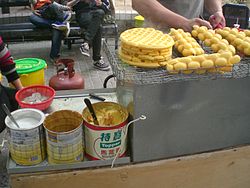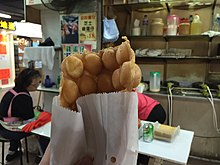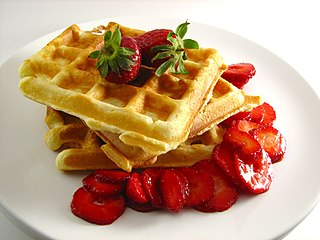
A waffle is a dish made from leavened batter or dough that is cooked between two plates that are patterned to give a characteristic size, shape, and surface impression. There are many variations based on the type of waffle iron and recipe used. Waffles are eaten throughout the world, particularly in Belgium, which has over a dozen regional varieties. Waffles may be made fresh or simply heated after having been commercially cooked and frozen.

A pancake is a flat cake, often thin and round, prepared from a starch-based batter that may contain eggs, milk and butter, and then cooked on a hot surface such as a griddle or frying pan. It is a type of batter bread. Archaeological evidence suggests that pancakes were probably eaten in prehistoric societies.

Æbleskiver are spherical Danish snacks made from fried batter. The name literally means "apple slices" in Danish, although apples are not usually an ingredient in present-day versions. The crust is similar in texture to European pancakes, but with a light and fluffy interior similar to a Yorkshire pudding. The English language spelling is usually aebleskiver,ebleskiver or ebelskiver.
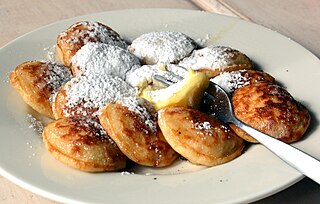
Poffertjes are a traditional Dutch batter cakes. Resembling small, fluffy pancakes, they are made with yeast and buckwheat flour. Typically, poffertjes are sweet treats served with powdered sugar and butter, and sometimes syrup or advocaat. A savoury variant with gouda cheese is also made.

Boxty is a traditional Irish potato pancake. The dish is mostly associated with the north midlands, north Connacht and southern Ulster, in particular the counties of Leitrim, Mayo, Sligo, Fermanagh, Longford, and Cavan. There are many recipes but all contain finely grated, raw potatoes and all are served fried.

A rice cake may be any kind of food item made from rice that has been shaped, condensed, or otherwise combined into a single object. A wide variety of rice cakes exist in many different cultures in which rice is eaten. Common variations include cakes made with rice flour, those made from ground rice, and those made from whole grains of rice compressed together or combined with some other binding substance.
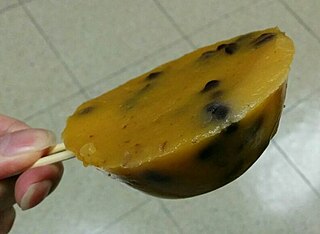
Put chai ko is a popular snack in Hong Kong. The pudding cake is palm size and is sweet in taste. It is soft, but can hold its molded shape outside a bowl. The cake is made from white or brown sugar, long-grain rice flour with a little wheat starch or cornstarch. Sometimes red beans are also added. The batter is poured into porcelain bowls and steamed until cooked through. Then it is allowed to cool and served at room temperature. Traditionally, the hawker inserts two bamboo skewers into the cake to turn it out and the eater holds the skewers to consume. At present, most Put Chai Ko are sold in plastic bags.

Kue semprong, Asian egg roll, sapit, sepit, kue Belanda, or kapit, is an Indonesian traditional wafer snack made by clasping egg batter using an iron mold which is heated up on a charcoal stove. It is commonly found in Indonesia, Malaysia, Singapore and Brunei.

Hong Kong street food is characterised as the ready-to-eat snacks and drinks sold by hawkers or vendors at food stalls, including egg tarts, fish balls, egg waffles and stinky tofu, according to the definition provided by the Food and Agriculture Organization. They can be found throughout the city, especially in the areas of Mong Kok, Causeway Bay, Yuen Long, Tsuen Wan, and Kwun Tong.

The Tai On Building is a residential and commercial building in Sai Wan Ho, Hong Kong. It was once one of the largest buildings in the district and remains a landmark. The ground floor arcade is well known for its many snack shops.

Kue gapit is an Indonesian kue kering which originates from Cirebon, West Java. Generally made from tapioca flour, its name comes from the cooking process, in which it is grilled between iron molds like a waffle. The snack comes in a variety of shapes and flavors. Though it is a popular souvenir among visitors to Cirebon, residents of the region rarely eat it.

Jianbing guozi or "deep-fried dough sticks rolled in a thin pancake" is a popular Chinese street food originating in Tianjin. The exact origin of Jianbing guozi has not been verified, and it was the supplement of Tianjin Ta Kung Pao on November 20, 1933, that first appeared in modern newspapers. In June 2017, the skill of making Jianbing guozi was included in the fourth batch of municipal intangible cultural heritage list in Tianjin. And has been hailed as "one of China's most beloved street breakfasts", especially in Tianjin and the neighboring province of Hebei. It is a sub-category of jianbing and consists of pancakes made from mung bean flour, eggs, and youtiao or crispy "dragons", served with sweet bean sauce, diced green onion, and optionally chili sauce.

Kue rangi or also called sagu rangi is an Indonesian coconut kue or traditional snack made of a coconut and starch-based batter and cooked in a special molded pan. It is one of the traditional Betawi snack of Jakarta. Kue rangi often described as Indonesian coconut waffle.

Kue pukis or simply called Pukis is an Indonesian kue or traditional snack made of a wheat flour-based batter and cooked in a special mold pan. It is a commonly found snack in Indonesian traditional markets.

Indo cuisine is a fusion cooking and cuisine tradition, mainly existing in Indonesia and the Netherlands, as well as Belgium, South Africa and Suriname. This cuisine characterized of fusion cuisine that consists of original Indonesian cuisine with Eurasian-influences—mainly Dutch, also Portuguese, Spanish, French and British—and vice versa. Nowaday, not only Indo people consume Indo cuisine, but also Indonesians and Dutch people.

DanBing (dànbǐng), also known as egg pancake or rolled egg crepe, is a Taiwanese breakfast dish. Different regions makes the dish differently, in most cases, the dough is made by kneading flour, potato starch, glutinous rice flour, and water into a thin dough, and an omelet is baked on top of the dough. In Taiwan, dan bing is mainly sold at breakfast shops, restaurants as well as night market food stalls. They are also sold commercially in supermarkets, where the dough is frozen in plastic packaging, and egg is added as the dough is heated.
